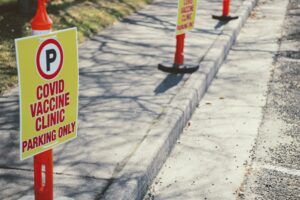Editor’s note: This op-ed was first published in MarketWatch on May 24, 2022.
Last spring I wrote a commentary for MarketWatch predicting that COVID-19 would be under control by Memorial Day 2021 as it faded into something approaching a normal flu.
Instead, by Memorial Day 2022 we have surpassed one million deaths in the U.S. Waves of new virus variants arrive with alarming descriptions, and public health officials are warning us to keep masks handy and minimize indoor meetings.
Here is a reset: We are in better shape than we were at this time last year, but we are nowhere close to having COVID “under control.” Indeed, we may not even care that much about that goal anymore. A look back will help us understand how we got to this point, and what lessons might help us going forward.
What led to my optimism last year?
In late February 2021 I had just returned from volunteering at a makeshift clinic in a public park near downtown Los Angeles. An army of volunteers, mostly from the USC School of Pharmacy, had just vaccinated 2,100 seniors, 15 times more people than Los Angeles County reported getting infections each day. Pfizer PFE, 1.08% and Moderna MRNA, -3.87% were expected to deliver at least 3 million shots daily over the next month and a half.
Sign up for Schaeffer Center news
Given these projections and CDC estimates that about 110 million Americans (one-third of the population) had already had the virus and thus some natural immunity, I concluded that the virus was on the run.
Why was I so wrong? Three reasons come to mind.
First, I greatly underestimated how many people would not take the vaccines. Safety was a concern, but so was distrust of the government and the pharmaceutical industry. Clinical trial and real-world evidence could not overcome the image of drugmakers rushing vaccines to the market based on new technologies, financially backed and legally protected by the federal government. It was an ideal combination for conspiracy theorists.
Second, I didn’t appreciate the unpredictability of a new pathogen. My excuse: I’m a health economist, not an epidemiologist. Even so, many card-carrying epidemiologists and infection disease specialists got plenty wrong as well.
There were endless debates about reaching herd immunity; warnings of cold-weather spikes that were preceded and sometimes exceeded by summer surges; and success stories from states or countries that later were back in the crosshairs of the pandemic.
Meanwhile, the virus kept mutating, going from beta to the more lethal delta, followed by the more transmissible omicron, and now its subvariant cousins.
It is now clear that COVID vaccines substantially reduce the risk of hospitalization and death, but offer only modest, temporary protection against infection from newer variants. The same is true for natural immunity.
Finally, the near-complete reopening of society both here and abroad — a good thing in most respects — increases the likelihood that the virus will continue to be transmitted and mutate, particularly if vaccine access and uptake remain low in many countries around the world.
South Africa is a good example, where much of the population has been infected while relatively few have been vaccinated. The newest subvariants (BA.4 and BA.5) of the original omicron variant have led to a tripling of new infections in South Africa over the past month. Preliminary studies find that individuals who are vaccinated and had recovered from a breakthrough infection neutralized BA.4 and BA.5 at a level that was fivefold higher than those who are unvaccinated.
This suggests that the recent spike in infections is being driven by the unvaccinated, and what happens in Johannesburg (or Beijing or Mumbai) does not stay there.
So what is a realistic replacement for keeping COVID “under control?”
It may not look like seizing the upper hand as much as keeping pace as new variants emerge. Vaccines need to advance, especially to block infections as well as minimize consequences. Therapeutics, such as monoclonal antibodies and Pfizer’s antiviral pill Paxlovid, need to be more widely available. Lockdowns may be gone but companies, campuses and individuals still face choices over masking and precautions that will be inconvenient yet might help avoid breakthrough infections.
I remain cautiously optimistic. Let’s forget about predictions and put our faith in our ability to learn from the past. We can say with certainty that if we keep evolving our responses, the odds for better outcomes improve, and that may be as good as it will get.
Geoffrey Joyce is director of health policy at the USC Schaeffer Center for Health Policy & Economics.
Related Work
-
Press Release
Traditional Vaccination Playbook Doesn’t Work with COVID



